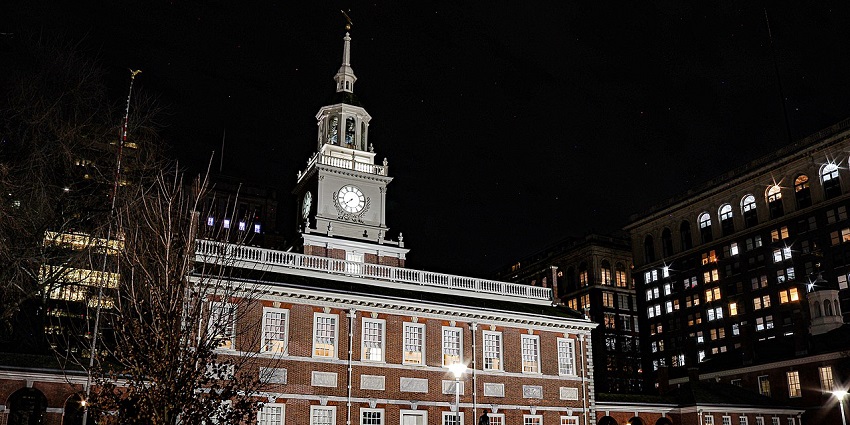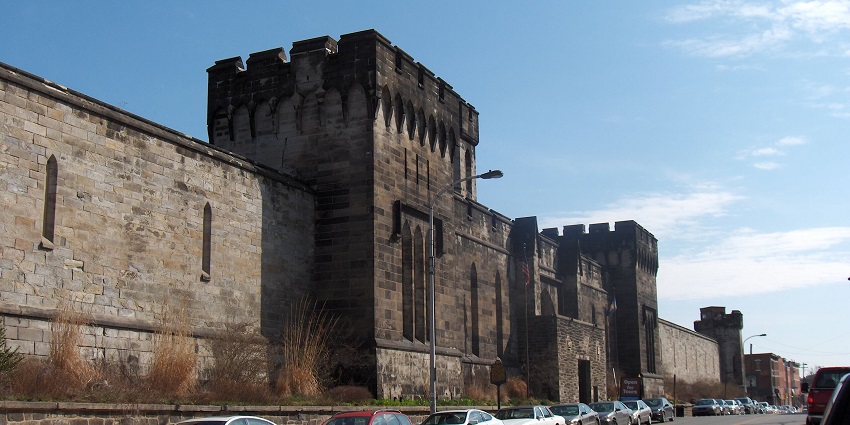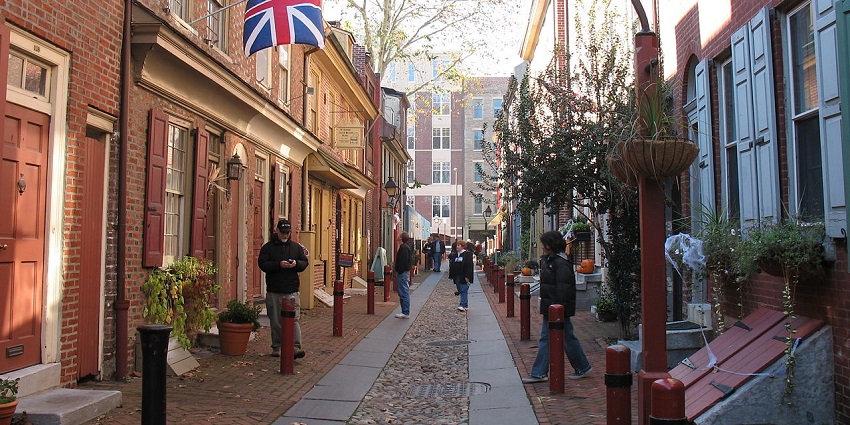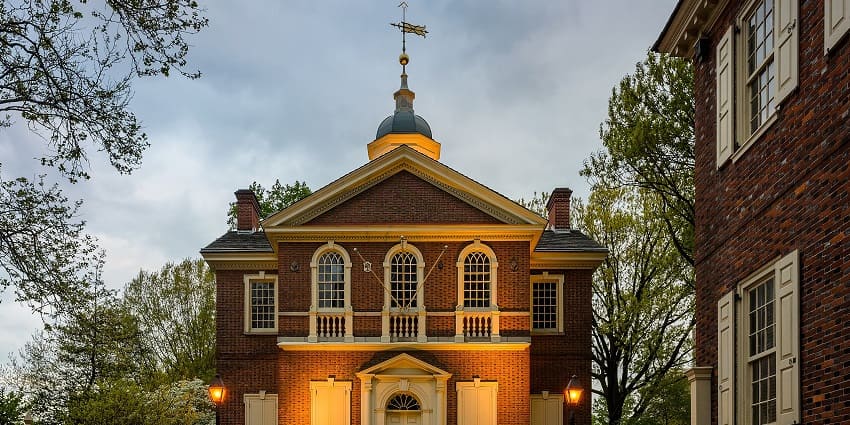In Philadelphia, history is something you can touch through the city’s old buildings, brick alleys, and worn steps. These historical places in Philadelphia were never meant to be monuments. They were workspaces, meeting halls, and family homes now holding the memory of choices that shaped the country. You walk the same ground as Franklin, listen to where the Liberty Bell once rang out, and feel time settle into stone. This is where the story of America moved from thought to action.
10 Famous Historical Places In Philadelphia
Here are the historical places in Philadelphia offering more than stories and show where key events unfolded and where the past still shapes the present:
1. Independence Hall

Photo: Abhiram Juvvadi / Wikimedia Commons
Independence Hall is where the American colonies took their boldest step, signing the Declaration of Independence in 1776, later the U.S. Constitution in 1787. The red-brick Georgian structure appears simple from the outside. Its Assembly Room remains one of the most important spaces in American history. Standing inside the hall, you can see the high-backed Windsor chairs, the rising sun carved on George Washington’s seat, and the room set as it was during the debates. The site is part of Independence National Historical Park and is now recognised as a UNESCO World Heritage Site. It is heavily protected, but entry feels intimate and personal.
Timings: 9 AM – 5 PM
Nearby Attractions: Liberty Bell Center, National Constitution Center, Independence Visitor Center
2. Liberty Bell Center

Photo: Toadspike / Wikimedia Commons
The Liberty Bell, cracked yet complete, is one of the most recognised symbols of American freedom. Housed inside the Liberty Bell Center this bell once rang from the steeple of the Pennsylvania State House. Visitors can stand close to the bell, study its hairline crack, and trace its journey from a colonial relic to a modern emblem of justice. The exhibit inside the centre provides photos, films, and personal stories that link the bell to centuries of protest and promise. Large glass walls offer a view of Independence Hall, bridging the object and the ideas it represents.
Timings: 9 AM – 5 PM
Nearby Attractions: Independence Hall, President’s House Site, Franklin Court
3. Betsy Ross House

Photo: ajay_suresh / Wikimedia Commons
The Betsy Ross House tells the story of the woman believed to have sewn the first American flag. Tucked into Arch Street, the 18th-century home is carefully preserved and offers a close look at colonial life. The house is full of detail in narrow staircases, original woodwork, and rooms arranged just as they would have been during her time. Inside, a costumed interpreter often brings Betsy’s story to life, sharing her work as an upholsterer. The courtyard and gift shop carry the theme through with flags, period items, and hands-on exhibits.
Timings: 10 AM – 5 PM
Nearby Attractions: Elfreth’s Alley, Christ Church, Museum of the American Revolution
4. Eastern State Penitentiary

Photo: Davidt8 / Wikimedia Commons
Eastern State Penitentiary opened in 1829, changed the way prisons were designed across the world. Some of the original doors still hang on their rusted hinges. One of its most talked-about rooms is the furnished cell where Al Capone was once held, complete with rugs, a desk, and a soft lamp. Though it shut down in 1971, much of it remains decayed, silent, and full of uneasy memories among other historical places in Philadelphia. Today, visitors walk through its cold halls with audio guides and see exhibits that dig into both the prison’s history and America’s prison system.
Timings: 10 AM – 5 PM
Nearby Attractions: Philadelphia Museum of Art, Rodin Museum, Franklin Institute
5. Christ Church

Photo: J. Passepartout / Wikimedia Commons
Christ Church stands at the heart of Philadelphia’s Old City and holds nearly 300 years of layered history. The steeple, once the tallest point in North America, still cuts through the skyline. Inside, the wooden pews remain worn from use, the brass chandeliers hang as they did centuries ago, and the high pulpit casts long shadows in the quiet light. Just a few blocks from the church, the burial ground holds the graves of several signers of the Declaration of Independence. Today, Christ Church still functions as a place of worship, but its doors stay open for those who come to witness a part of the city’s beginning.
Timings: 12 PM – 4 PM ( closed on Sunday)
Nearby Attractions: Christ Church Burial Ground, Elfreth’s Alley, Betsy Ross House
6. Elfreth’s Alley

Photo: Kjetil Ree / Wikimedia Commons
Elfreth’s Alley is the oldest continuously inhabited residential street in the United States. Dating back to 1703, this narrow cobblestone lane is lined with preserved Georgian and Federal-style homes. Walking through it feels more like entering a painting than a historic site. Numbers 124 and 126 have been turned into a small museum where visitors can learn about daily life during the colonial period. See laundry lines, shutters, flower boxes, and flagstones. You are free to stroll the street at any time, though the museum offers a look into the people who shaped this corner of Philadelphia.
Timings: 12 PM – 4 PM (Friday to Sunday for museum)
Nearby Attractions: Betsy Ross House, Christ Church, Franklin Square
7. Philadelphia City Hall

Photo: John Phelan / Wikimedia Commons
Philadelphia City Hall rises from the centre of the city like a stone monument to craftsmanship and civic pride. Built over three decades and completed in 1901, it remains the largest municipal building in the United States. Its elaborate Second Empire style shows in every detail in granite carvings, arched passageways, and more than 250 sculptures worked into the structure. The 548-foot tower is crowned by a statue of William Penn, which stood for years as the city’s highest point. Inside, wide marble staircases and high-ceilinged rooms serve as offices, courtrooms, and council spaces still in daily use.
Timings: 9:30 AM – 4:30 PM (Monday to Friday)
Nearby Attractions: Dilworth Park, LOVE Park, Masonic Temple
8. Carpenters’ Hall

Photo: Pbjamesphoto / Wikimedia Commons
Carpenters’ Hall may look modest compared to some grand city structures, but its role in American history is impossible to overlook. The building was owned by the Carpenters’ Company, a guild of master builders whose original tools and records are still on display inside. The interior is simple with wooden floors, red chairs, and a large meeting table. It was in this very space that discussions first turned to revolution. Unlike reconstructed sites, this building stands with much of its original structure intact among historical places in Philadelphia.
Timings: 10 AM – 4 PM ( closed on Monday)
Nearby Attractions: Independence Hall, Second Bank Portrait Gallery, Liberty Bell
9. Congress Hall

Photo: tim eschaton / Wikimedia Commons
Congress Hall sits quietly beside Independence Hall and played a central role in the early years of the United States government. It was here that George Washington’s second inauguration took place and where laws that helped shape the young republic were passed. The building itself is modest in design with brick walls, wooden desks, and a layout that reflects function over form. But the events that happened inside gave structure to a nation still finding its footing. Congress Hall remains as it was, with guided tours allowing visitors to step directly into rooms where some of the country’s earliest decisions were debated and decided.
Timings: 9 AM – 5 PM
Nearby Attractions: Liberty Bell Center, Philosophical Hall, Old City Hall
10. Franklin Court

Photo: Beyond My Ken / Wikimedia Commons
Franklin Court sits on the ground where Benjamin Franklin’s house once stood, right in the centre of historic Philadelphia. Instead of rebuilding the home, a steel outline marks its former walls, leaving the space open but clearly defined. Below the courtyard, the Benjamin Franklin Museum offers a quiet, in-depth look at his life. Displays include his letters, printed works, personal items, and scientific tools. Exhibits are arranged around themes such as printer, scientist, diplomat, and citizen, showing how many roles he held. Visitors can listen to his words, examine replica inventions, and move through a timeline that connects his personal story with the country’s early years.
Timings: 9 AM – 5 PM
Nearby Attractions: Independence Hall, Betsy Ross House, National Museum of American Jewish History
These historical places in Philadelphia are not roped off behind glass or buried under plaques. They remain active, visible, and close enough to touch. You can walk through the same doorways as the country’s founders and sit in the same chambers where laws were shaped. Whether you are visiting for a weekend or diving deep into American heritage, Philadelphia’s streets give you context, understanding, and a lasting connection to the past. Plan your visit with TripXL and step straight into history, one landmark at a time.
Cover Photo: Ken Thomas / Wikimedia Commons


 WhatsApp
WhatsApp
 Twitter
Twitter









